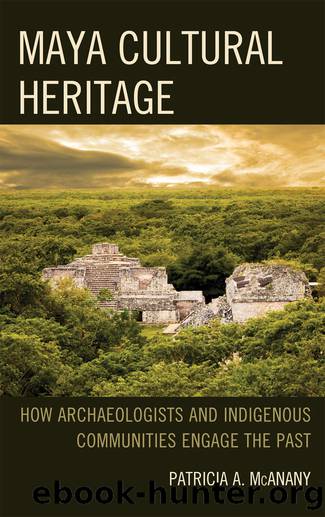Maya Cultural Heritage by McAnany Patricia A.;Rowe Sarah M.;

Author:McAnany, Patricia A.;Rowe, Sarah M.;
Language: eng
Format: epub
ISBN: 4659309
Publisher: Rowman & Littlefield Unlimited Model
FORGING PARTNERSHIPS AROUND HERITAGE ISSUES
Chapter 1 opened with this question from a young Yucatec Maya Belizean girl: âWhy did all the Maya have to die?â That question stayed with me because of its sadness and what it revealed about colonial mythologies and the lack of access to information about the past. In the years that followed, I became increasingly concerned about the vulnerability of Indigenous Maya children, who grow up feeling like second-class citizens in their own homeland and experience discrimination because of the way they look, the clothes they wear, or the maternal language they speak (or are discouraged from speaking). Living in rural districts, many children lack access to schools with an enriched curriculum at which they might learn about their distant ancestors rather than a history that begins with European colonization. The structural inequalities of growing up with three strikes against you and few opportunities to change a preordained script were very much on my mind in 2005.
At that time, I had received a fellowship from the National Endowment for the Humanities to write a book about the embedded nature of precolonial Maya economic arrangements.55 I was absorbed with archaeological evidence and social theory when I received word that the director of a family foundation was interested in speaking with me about funding programs in the Maya area that would curb looting and also be beneficial to local Maya populations. Initially, I thought I would take a pass on the opportunity since applied research had never been part of my professional activities. I was concerned about social justice intellectually but at the time did not feel compelled to link that concern with the practice of archaeologyâa space within which I sense many of my colleagues dwell today.
But as I thought over the possibilities, I realized that I had been offered a once-in-a-lifetime opportunity. The director was persuasive and supportive, and soon I was tasked with writing a proposal that outlined a plan of action. But what kind of action could make a difference? I had just completed multiple years of fieldwork in the Sibun Valley of Belize and was entering an analysis and writing phase. There were fascinating and diverse communities living in and near the valley: Creole (Afro-European Belizeans), Anglo-Belizeans, U.S. and European expatriates, Chinese Belizeans, refugees from the Salvadoran civil war, and retired chicle harvesters. Interesting and important community archaeology certainly could happen in this location. But earlier fieldwork in northern Belize and Yucatán had sensitized me to the compelling issues embedded within the linkage between ethnolinguistic Mayan communities and archaeological sites located within the ambient heritage-scape. Despite the colonial-period presence of Mayan peoples (probably Yucatec speakers) in the Sibun Valley attested by ethnohistoric research,56 such communities no longer existed.
As I mulled over a course of action, one of my Boston University graduate students and research assistantsâShoshaunna Parksâsuggested that we take a multisited approach to Maya cultural heritage. As discussed in chapter 4, multisited ethnographyâintroduced by sociocultural anthropologist George Marcus in the 1990sâprovides a comparative
Download
This site does not store any files on its server. We only index and link to content provided by other sites. Please contact the content providers to delete copyright contents if any and email us, we'll remove relevant links or contents immediately.
The Daily Stoic by Holiday Ryan & Hanselman Stephen(3116)
The Fate of Rome: Climate, Disease, and the End of an Empire (The Princeton History of the Ancient World) by Kyle Harper(2884)
People of the Earth: An Introduction to World Prehistory by Dr. Brian Fagan & Nadia Durrani(2622)
Ancient Worlds by Michael Scott(2504)
Babylon's Ark by Lawrence Anthony(2438)
Foreign Devils on the Silk Road: The Search for the Lost Treasures of Central Asia by Peter Hopkirk(2393)
The Daily Stoic by Ryan Holiday & Stephen Hanselman(2356)
India's Ancient Past by R.S. Sharma(2308)
MOSES THE EGYPTIAN by Jan Assmann(2283)
The Complete Dead Sea Scrolls in English (7th Edition) (Penguin Classics) by Geza Vermes(2147)
Lost Technologies of Ancient Egypt by Christopher Dunn(2125)
The Earth Chronicles Handbook by Zecharia Sitchin(2106)
24 Hours in Ancient Rome by Philip Matyszak(1978)
Alexander the Great by Philip Freeman(1968)
Aztec by Gary Jennings(1884)
The Nine Waves of Creation by Carl Johan Calleman(1789)
Curse Tablets and Binding Spells from the Ancient World by Gager John G.;(1773)
Before Atlantis by Frank Joseph(1744)
Earthmare: The Lost Book of Wars by Cergat(1719)
